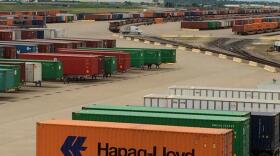Interstate 30 from Dallas into Northeast Texas is changing – and even more changes are coming. In the second of three installments, KETR’s Mark Haslett speaks with North Central Texas Council of Governments Transportation Director Michael Morris.
Haslett: Service roads, frontage roads, access roads, feeders – whatever you call them, they’re a part of life around an interstate highway. In the country, these roads are often two-way thoroughfares. This allows for people to go in either direction along the highway without having to cross the highway. That’s important along stretches where you can go for miles without finding an opportunity to cross or even enter the main highway itself.
Morris: Two-way frontage roads are fine in low-volume, rural situations where the users are pretty accustomed to it – there’s not a lot of cars - not necessarily a whole bunch of new folks traveling on it that aren’t used to that situation.
Haslett: That’s North Central Texas Council of Governments Transportation Director Michael Morris. This week, we’re discussing future improvements along Interstate 30. The problem with the two-way frontage roads according to most transportation planners is that they’re not safe. They don’t work well with high volumes of traffic and can be confusing – especially to city-dwellers passing through who are unaccustomed to navigating such roads.
Morris: As urban regions expand, we’re very sensitive to reviewing where the two-direction frontage roads are and then move the community to build them where you have one lane on each direction. Now the controversy usually comes in where the circuity of – “Hey, I really want to go in the other direction. I used to be able to go two ways on this frontage road. If you make me do this, the down side is I got to travel three miles in this direction then three miles all the way back to get to where I’m trying to go. That’s too much driving for what used to be a half-mile trip.”
Haslett: Morris says the solution to that problem lies in the fact that frontage road redesign is usually accompanied by other improvements that are all part of making a once-rural stretch of highway into one that can handle suburban levels of traffic volume.

Morris: So what you often have to do in transportation is to build another bridge in the middle of those sections – a new bridge where they can turn around and go in the other direction.
Haslett: North Central Texas Council of Governments Transportation Director Michael Morris. We’ll conclude our conversation about improvements along Interstate 30 tomorrow during All Things Considered.





